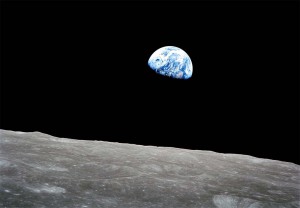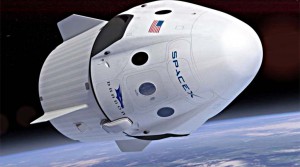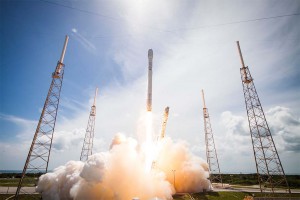
If all goes according to plan, two paid "tourists" will get to see this view for the first time since the Apollo mission ended in 1972.
Elon Musk has long been shooting for the moon, and now he wants to do it quite literally. The founder of both Tesla, the electric vehicle maker, as well as rocket launch company SpaceX, says he intends to send two “tourists” on a week-long trip to orbit the moon a little more than a year from now.
They’d ride in a modified version of the Dragon spacecraft that SpaceX is planning to use to begin ferrying astronauts to the International Space Station as early as 2018, allowing NASA to stop relying on the Russians to get there. According to Musk, there are already two paying customers who have plunked down a “significant deposit” for the lunar mission.
“Next year is going to be the big year for carrying people,” Musk said during a news conference. “This should be a really exciting mission that hopefully gets the world really excited about sending people into deep space again.”
It would mark the first time a human has come close to the moon since NASA’s last mission ended with Apollo 17 in December 1972. That 12-day mission, of course, also included a lengthy stay on the lunar surface. While Musk has, in the past, talked about a similar effort, the trip currently being planned would be limited to orbiting our nearest astronomical neighbor.
(Investors grow worry as Tesla’s troubles mount ahead of Model 3 launch. Click Here for the story.)
Whether SpaceX can meet the schedule Musk is outlining remains to be seen. The company only this month get back into business supplying the space station, or ISS, after a disastrous launch pad explosion destroyed one of its unmanned rockets.
Musk insists that SpaceX has nonetheless put together an impressive record and is in the midst of debugging its Crew Dragon spacecraft. The company would then have to convince the Federal Aviation Administration to issue the appropriate paperwork to start flying humans into space.
The South African-born entrepreneur has outlined a number of goals for manned flight, and it seemed likely the first step would be the space station runs. Going to the moon would push a significant step beyond because it would not only require outfitting the Crew Dragon for a longer stay in space, but also mean launching SpaceX’s new Falcon Heavy rocket to much higher speeds.
To reach Earth orbit means hitting about 18,000 miles an hour. To escape the planet’s gravity requires pushing that to 25,000 mph. Meanwhile, SpaceX would also have to slow the craft down again to insert the Crew Dragon craft into lunar orbit. Then, it has to fire up its rockets to bring the two space tourists back to Earth. And doing that safely, especially at the speeds they would return at, involves an additional series of challenges beyond what an ISS crew would experience.
Nonetheless, Musk said there already are two paying customers on line for the mission. He wouldn’t reveal how much they’re paying, but hinted that the price gag will be “comparable” to that of going to the space station. The Russians reportedly have charged several private visitors to the ISS about $80 million.
Training for the SpaceX tourists will begin later this year, according to Musk, and the moon launch is set to take place, at least tentatively, during the second quarter of 2018.
(Tesla posts Q4 and full year loss. Click Here for the story.)
It would not mark the first time civilians have gone into space, several already riding those Russian rockets to the ISS. But SpaceX appears to be hoping to claim honors of being the first private company to both launch astronauts to the space station and to send tourists into deep space.
And Musk said this isn’t a one-shot, telling reporters he sees moon orbits becoming “a significant driver of revenue” for SpaceX.
He has previously hinted of putting a human on the moon’s surface as well, but Musk has turned his sights to a further target, outlining plans to launch a manned mission to Mars in the not-too-distant future.
If the moon mission succeeds, it could position SpaceX as a more aggressive explorer of “the final frontier” than NASA. The U.S. space agency is itself is readying its long-awaited replacement for the giant Saturn V moon launcher, as well as the Orion crew capsule. Nudged by the new Trump Administration, it has floated the idea of switching from unmanned to manned for the first planned flight, scheduled for late 2018.
That has triggered extensive debate about the safety of such a move. And whether SpaceX will also be reined in on its aggressive lunar mission schedule remains to be seen.
Musk did note that he would be glad to shift SpaceX’s plans to work with the company’s biggest customer.
“If NASA decides to have a mission of this nature be a NASA mission, then of course NASA would take priority” on a moon mission, he said.
(UAW gearing up for organizing battle at Tesla plant in California. Click Here for the story.)



We need more people like Musk.